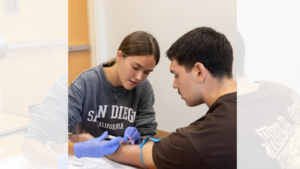Chronic Obstructive Pulmonary Disease (COPD) is a serious lung disease that makes it difficult to breathe. It’s characterized by inflammation and narrowing of the airways, often caused by long-term exposure to irritants. While COPD can significantly impact your quality of life, early diagnosis and management can help you breathe easier.
Symptoms
Patrick Stevens, Director of Cardiopulmonary Services at CCMH, says the symptoms of COPD can vary from person to person and may develop gradually.
“Symptoms of COPD don’t just appear out of nowhere. It takes time to realize your lung function isn’t normal for you. For instance, if you have to stop and rest after a short amount of physical activity or if you can’t perform up to the same ability as someone your own age with relatively the same health status, you may want to see your medical provider.”
Stevens says some common symptoms of COPD include:
- Shortness of breath
- Chronic cough
- Wheezing
- Chest tightness
- Frequent respiratory infections
- Fatigue
- Weight loss
Risk Factors
Several factors can increase your risk of developing COPD according to Stevens.
“The most common risk factor and leading cause of COPD is smoking. Others that people don’t think about, and are common in Iowa because of agriculture, are farm chemicals. Any operation that involves raising chickens or turkeys can also produce chronic lung issues. Age and genetics are additional risk factors in developing COPD that are beyond our control.”
Diagnosis
If you’re experiencing symptoms of COPD, it’s important to see a healthcare provider for a diagnosis. They may perform various tests, including:
- Pulmonary function tests (PFT): These tests measure how well your lungs function.
- Chest X-ray: This can help identify lung abnormalities.
- CT scan: This can provide a more detailed image of your lungs.
- Blood tests: These may be used to rule out other conditions.
Managing COPD
While there’s no cure for COPD, Stevens notes there are treatments to help manage symptoms and slow disease progression.
“Common treatments include medications like inhalers with bronchodilators and corticosteroids to help relax the airways and reduce inflammation. There’s also pulmonary rehabilitation involving exercise, education, and counseling to improve lung function. Most people are familiar with oxygen therapy. In some severe cases, surgery may be an option to improve lung function.”
Preventing COPD
Stevens has advice for the best way to prevent COPD — quit smoking and limit exposure to irritants.
“The only surefire method to avoid COPD is to quit smoking. If you work on the farm, limit your exposure to air pollution, chemicals, and grain dust. Eat a balanced diet and get some regular exercise. You can also take one, extra, easy step and get vaccinated for flu and pneumonia to reduce the risk of respiratory infections.”
By understanding COPD, recognizing its symptoms, and taking proactive steps to manage the condition, you can improve your quality of life and breathe easier. If you have concerns about COPD, talk to your healthcare provider. If you do not have a primary medical provider, contact the CCMH Medical Clinic at 712-265-2700 or go online at ccmhia.com to request an appointment.


